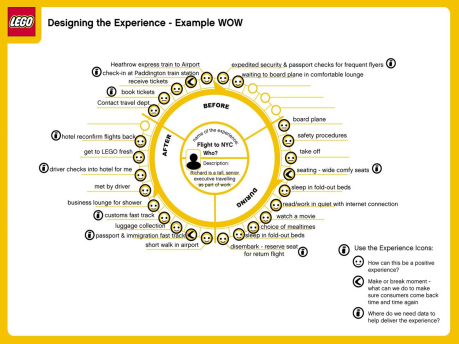LEGO’s Building Block For Good Experiences
March 3, 2009 28 Comments
I recently chatted with LEGO about their customer experience efforts; they’ve got a lot of interesting initiatives underway. One of the things that really caught my eye was a tool they call the “experience wheel.” They were gracious enough to let me share it (you can click on the image to see a larger version):
This is an example of the output after a couple of steps; showing an approach to design a WOW experience for a flight to NYC. Here are some of the reasons that I really like this tool:
- It’s great to have a formal approach to describing/designing experiences
- It starts with the description of a specific customer (in the center)
- It recognizes the life cycle of experiences: before, during, and after
- It’s easy to use and simple to understand
If you’ve got a tool that works for you, I’d love to see it!
The bottom line: Experience design can be a discipline!

Pingback: LEGO’s Building Block For Good Experiences « erik albin dahl
Pingback: Cecilia Weckstrom
it’s a very nice map Bruce. useful in order to have a clear picture of the user experience. Do you know if there are similar examples (about mapping techniques of user experiences)? Many thanks.
This is an interesting update to the Moment of Truth Chart and the Cycle of Service Chart shown by Karl Albrecht in “The Only Thing That Matters” (pp 220,221)
In its simplified form, I find it extremely useful with Small Business owners – it’s not too “academic”, and it helps visually track the Customer’s movement across every significant touchpoint, then it helps isolate each touchpoint one by one for critical analysis and intentional Customer Experience design.
I also refer to “Marketing Your Services” by Anthony O. Putman to create “intentional relationships” (as opposed to the usual “whatever happens” approach). His Chapter Six gives the blueprint for creating “Laser-Like Alignment” – a very useful construct when building the Customer Experience “Should Be” model for each Moment of Truth/touchpoint.
Blend these with a Kano analysis and you’ve really got something!
//RR
Cecilia: Thanks for sharing your feelings. You’re doing some great work at LEGO, so it’s really my pleasure to share it — keep it up!
nico: Given the popularity of this blog post, I will start asking companies if they’ll share bits like this.
Richard: Thanks for adding the additional references. Also, I am a big fan of the Kano Model!
Pingback: theBside » Blog Archive
Pingback: Bookmarks 1st-8th March « Love to learn
Pingback: Experience let down by a jobsworth | dancingmango
Pingback: LEGO’s wheel « Inside My Ideas
Pingback: Wheel in the Sky « Sound Loyalty
Pingback: Design Ethnography & Mood Maps
Interessting. We have done such a mission to analyze the UX of brussels Airlines. http://www.slideshare.net/guestdb7161/brussels-airlines-case-study-belgian-usability-day-presentation
Another presentation that’s ionteresting is service design http://www.slideshare.net/IAfromBrussels/service-design-by-c-rowland
😉
Robi: Thanks for sharing the links; the presentations were very interesting. I particularly liked the slide show about the Website design for Brussels Airlines — looks like excellent work.
Pingback: Johnny Holland - It’s all about interaction » Blog Archive » Design Ethnography & Mood Maps
Pingback: Design Ethnography & Mood Maps | UxSoup
Pingback: A bit of a round up « Inside the head of a designer
Pingback: Recent reads « learn.amniisia.com
Sorry, If this sounds silly. But what does this tool for?
Pingback: LEGO Baukasten für gute User Experience « UXgeist
Pingback: It’s All About Your Customer’s Journey « Customer Experience Matters
Pingback: The Wheel of Good Experience
Pingback: LEGO’s Building Block For Good Experiences « Bad Wolf Blues
nice work that you have here… can i use the illustration to help pep up my employees?
Pingback: CED- ympyrä | Essale Oy
Hi, we are a group of academics of an Univresity in Mexico, doing research on using experience for interactive media at museums. I was wondering how to analyse the information and come up with LEGO’s experience model, which have been a very useful way to map our observations and analyse data. Do you know how was the creator of this model so we can give proper reference, and also I would be glad to share our findings with their modifications, we are wondering if it could be an app to facilitate de documentation.
Pingback: Quora
Does anyone know of any software for customer touchpoint mapping? For example:
• Develop a “map” of how a prospect might come in contact with the company including independent agents, internal agents, advertising, print, call center, etc.
• Map the different “paths” a prospect might take on his or her way to becoming a customer through the point at which they are “onboard”.
• Identify customer “pain points” – certain places on the route where the business fails to provide excellent service.
Any ideas of products that can help a company do this?
I’d love to see how Lego actually populate this – that’s what I was hoping to see from this article – any more detail about their ‘initiatives that are under way’?
I designed a similar process for the BA.com process in 2003 just before they re-launched MMB. We used much more granular journey steps, and made it generic, then mapped each indivdual persona to the wheel (works out more practical when mapping large numbers of personas).
Lego’s approach to customer experience has seemed very old school and fragmented (not to mention expensive) for a while now. Nice to see that some of their latest products are very multichannel, some excellent ideas, but they often seem to miss one or two crucial details!